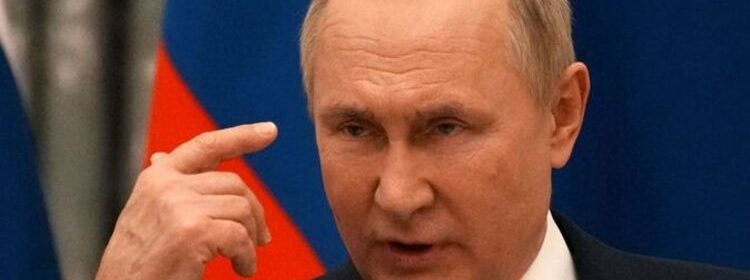‘EXACT’ date Putin to launch full-blown invasion – natural phenomenon exposes major clue

Boris pleads Putin to U-turn on 'disastrous' invasion plan
We use your sign-up to provide content in ways you’ve consented to and to improve our understanding of you. This may include adverts from us and 3rd parties based on our understanding. You can unsubscribe at any time. More info
The Russian President looks set to unleash his dogs of war on his western neighbour. Mr Putin has placed tens of thousands of troops on Ukraine’s northern, eastern and southern flanks. Many experts now believe an attack is inevitable, with the timing of the invasion one of the few questions left to be answered.
US President Joe Biden has reportedly briefed Western allies that he expects the Russian onslaught to begin this Wednesday on February 16.
Rob Lee, a security expert, believes that this date is more than credible when taking into account one important natural phenomenon – the moon.
He said: “Another relevant factor for the timing of a potential Russian military escalation: night illumination, which is important for operations at night.
“Illumination peaks on February 16th and falls to 52 percent by February 23.”
He added: “If the political decision has been made to use force, night illumination is one of the factors that would determine the exact timing, which might be one reason why the US government thinks Feb 16 is the likely date for an escalation.”
Moscow is continuing to ratchet up tensions over Ukraine and is showing no sign that it has any intention of de-escalating the current crisis.


On Monday, parliamentarians from Russia’s ruling party submitted a draft resolution on whether to formally recognise Ukraine’s two breakaway regions in the east of the country.
The proposal will be discussed and voted on by the Russian parliament, the Duma.
Any formal recognition of the Donetsk and Luhansk regions as independent would be a clear provocation.
It would also give the Kremlin the legal pretext to send its forces into Ukraine, if Moscow deemed that its citizens in those regions were under threat.
Michael Kofman, director of Russia Studies at the Center for Naval Analyses (CNA), said: “The proposed recognition of DNR/LNR to be reviewed by the Duma on February 14th looks like it may offer a basis for Russia to extend security guarantees, and militarily protect those considered to be Russian citizens living in the separatist regions.”


Despite Mr Putin’s apparent reluctance to find a diplomatic solution, Western leaders continue to make last minute efforts to avert a bloody war.
The Russian tyrant is set to welcome the new German Chancellor Olaf Scholz to Moscow on Tuesday, as yet another Western leader makes the pilgrimage to the Kremlin.
Mr Scholz will head to Moscow after meeting with the Ukrainian President Volodymyr Zelenskiy in Kiev on Monday.
Prior to his departure, German Chancellor warned Mr Putin that in the event of an attack “tough sanctions” would be “immediately put into force.”
Economic measures being considered are expected to target both Russian businesses and individuals in a range of sectors including chemical, defence, extractives, ICT and financial services industries.
DON’T MISS
Nuclear war: What happens if Russia bombs Ukraine? [ANALYSIS]
Boris urges Putin to U-turn on ‘disastrous’ invasion plans [SPOTLIGHT]
Bitter reason Russia threatening Ukraine invasion exposed [INSIGHT]

However, how effective sanctions will be in restraining the Russian aggressor is up for debate.
Moscow has worked hard to shore up its vulnerability to Western sanctions ever since its annexation of Crimea in 2014, when economic restrictions were first imposed.
Russia experts Michael Kofman and Andrea Kendall-Taylor noted in an article for Foreign Affairs that Moscow had successfully created budget surpluses and a growing war chest in the ensuing years.
They pointed to the size of Russia’s National Wealth Fund, which as of August 2021 contained $185billion.
Additionally, Mr Putin has at his disposal a massive $615billion in foreign reserves.
The confrontation over Crimea also spurred the Kremlin to reorientate trade away from the West and towards China.
Today, China is Russia’s most important commercial partner, with trade between the two states expected to exceed $200billion by 2024, double what it was in 2013.
Source: Read Full Article
